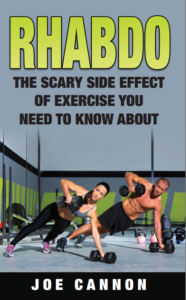Rhabdomyolysis (rhabdo) is a potentially serious complication from overexertion. While people are starting to discover how serious this health condition can be, few are aware that certain genetic traits can raise the risk of getting rhabdo. In this podcast of Joe Cannon Health (episode 13) I'll summarize 5 genetic traits that can elevate someone's risk of developing this health issue. While some have heard of the sickle cell trait, there are other genetic traits most have not heard of
This episode is important for parents of kids who have these genetic traits as well as PE teachers and coaches of college-level student-athletes.
Episode Summary
The myth of the week: do you have to cleanse or detox your colon to lose weight
What is rhabdomyolysis?
1 Malignant hyperthermia
2 Sickle Cell Trait
- What is sickle cell anemia, signs of the condition
- Sickle cell trait vs sickle cell anemia
- How many have this condition
- Exercise and sickle cell trait
- Sickle cell in the military and college athletes
3 McArdles disease
- What causes McArdles and what are the symptoms
- How to possibly recognize McArdles in kids
4 Duchenne's muscular dystrophy
- what is Duchenne's muscular dystrophy and how is it linked to rhabdomyolysis
5 Carnitine deficiency
- What does carnitine do and where do we get it from?
- Can carnitine supplements help rhabdomyolysis?
Quote of the week
References
- Malignant hyperthermia
- Malignant hyperthermia association of the united states
- Malignant hyperthermia susceptibility in patients with exertional rhabdomyolysis: a retrospective cohort study and updated systematic review.
- Malignant hyperthermia associated with exercise-induced rhabdomyolysis or congenital abnormalities and a novel RYR1 mutation in New Zealand and Australian pedigrees
- Exertional Rhabdomyolysis and Malignant Hyperthermia in a Patient with Ryanodine Receptor Type 1 Gene, L-type Calcium Channel α-1 Subunit Gene, and Calsequestrin-1 Gene Polymorphisms
- Sickle Cell Anemia (mayo clinic)
- What is Sickle Cell Trait (CDC)
- Sickle cell anemia in two White American children: essential laboratory criteria for diagnosis.
- Sickle Cell Trait and Sudden Death
- Drug and nutritional treatment for McArdle disease
- Emotionally-intense situations can result in rhabdomyolysis in McArdle disease.
- Glycogen storage disease type V
- Duchenne Muscular Dystrophy (DMD)
- Primary carnitine deficiency in a 57-year-old patient with recurrent exertional rhabdomyolysis
- NCAA Sickle Cell Trait For Coaches (PDF)
- NCAA: Sickle Cell Trait
- Information About McArdles Disease
- Emotionally-intense situations can result in rhabdomyolysis in McArdle disease.
- Protective effects of L-carnitine on myoglobinuric acute renal failure in rats.


I am a 35 year old male. In 2019 I wanted to get in shape. I started a workout with a friend who is a trainer and after the first time at the gym I developed Rhabdo. Dark urine ck levels over 100,000 and all. It was scary. I was hospitalized for 7 days. I know what happened because he pushed me beyond my comfort level. After that ordeal I quit working out.
So again in 2020 I decided to try again, this with a different friend who trains and after talking to him about my previous rhabdo we decided to take it easier. i guess not easy enough. The next day i felt tightness and out of fear I went to the er. Ck levels were elevated but only needed to stay overnight.
How can i begin a workout regimen to prevent this?
Kelz, Im really sorry to learn what happened to you. As you mentioned pushing behind your limits is what triggers many rhabdo cases. As I outlined in more detail in my book, the key to reducing the risk of rhabdo is progressing slowly. For strength training this means starting with just 1 set of an exercise. Most people do not need to do more than one set anyway.
Here is my rhabdo book on amazon if you want to check it out
Dont worry about small muscles like biceps and triceps. As you work the larger muscle groups like chest and back, you are engaging biceps and triceps so working them again becomes a bit redundant.
So I think the key is to get out of the old mindset that you have to do 3 sets of heavy weights to get a good workout. When it comes to reducing the risk of rhabdo, less is more.